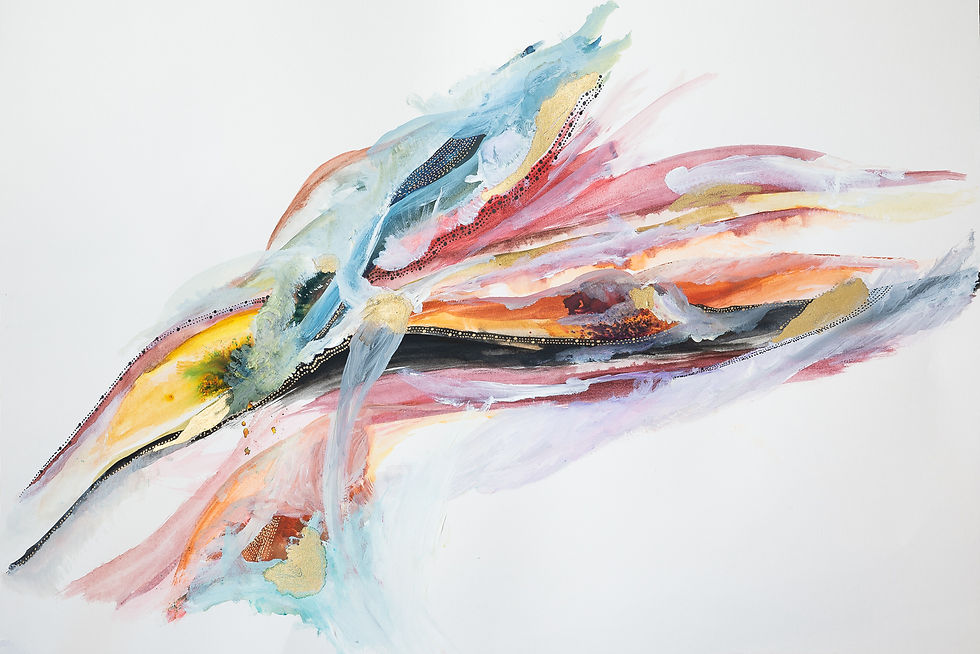The five meditation limbs of yoga
- Christine Dano Johnson
- Aug 27, 2021
- 4 min read

For the beginner looking to learn about different meditation styles, the information available can feel overwhelming. Although I've practiced meditation for almost as long as I've practiced yoga, I admit that the pull to sit in stillness doesn't call as loudly as the pull to move in my asana practice. It always feels so much easier to connect with my breath and stretch my body to reduce stress while maintaining near constant movement. However, growing in mindfulness asks us to be open and accepting of a variety of feelings, from anxiety to calm, and from sprinting to stillness. My current yoga teacher training is helping me understand the more meditative, contemplative limbs of the practice as opposed to only the ones that manifest in physical results.
Internet searches, books, websites, apps, and workshops have done wonders for spreading the heart-opening goodness of mediation and mindfulness practice. However, as with everything in the twenty-first century, information overload has muddied the waters considerably. When teaching others about mindfulness, I generally offer what's worked for me, which is meditation focused on the breath (pranayama). From box breathing to simply counting breaths, our breath provides us a portable and constant resource to become more aware, relaxed, compassionate, and yes, mindful. Breathwork is but one limb meditation in yoga, and by exploring and sharing the others, I hope to help both myself and those around me embrace the richness of a deeper mindfulness practice.
The path to yoga has eight elements, or limbs, and asana (physical postures) are only one of those elements. Five of the eight are meditative, and provide a beautiful foundation for those new to any mindfulness practice, or those looking to grow deeper.
Pranayama
Put quite simply, using the breath to center and focus. This can involve a practice such as box breathing, or the breath counting of Zen meditation. I've always found this the most accessible for those newly curious about mindfulness. Again, the breath is constant, and you can return to even as your focus wanes. There are countless techniques available and practitioners can find their own, individualized method that suits them. This type of meditation helps me when I'm feeling anxious off the mat or the zafu (which lately, this is often). Your breath goes with you everywhere, and it's (arguably) the only function in our bodies that is both automatic and controllable by our minds. When I'm practicing pranayama, I can gently ease into a quieter state. It's a good way to begin a longer meditation, or begin or end an asana flow.
Pratyahara
This style of meditation will be familiar to anyone who has heard of the term "body scan," or yoga nidra. This style of meditation has the practitioner turning inward, focusing on keeping energy in, and returning to self. Focusing on different areas of the body, often beginning at the feet and hands and moving up to the crown of the head, keeps the mind from wandering and softens the breath, body, and mind.
Dharana
By finding one point of focus, we can develop deeper relationships with our minds and bodies. Dharana can be walking meditation, either focuses on steps or along the lines of a labyrinth meditation, focusing on one yantra (image) or mantra (phrase or sound). Focusing on an image brings us out of the constant merry-go-round of thoughts and stimuli that compete for our attention. Deep focus on a piece of art, music, object, or something in nature can bring us fully into awareness and provoke feelings of calm, wonder, joy, and peace.

Sanskriti Museum of Indian Textiles, Delhi
Dhyana
Dhyana meditation invites us to contemplate a phrase, a concept, or a mystery. Catholics will recognize this sort of meditation, as it aligns beautifully with praying the Rosary. Thich Nhat Hanh teaches what he calls "Lovingkindness" meditation, or Metta. With this sort of meditation, we contemplate cultivating love and compassion with both ourselves and the world. We can also contemplate our relationship with a specific person (a loved one, or even someone that we're not currently getting along with), or more universal concepts such as love, peace, compassion, or sorrow. Fair warning: This sort of practice can bring up conflicted, or even painful emotions. Meditation and mindfulness are not only about finding bliss, but about radically accepting even the very difficult parts of our existence.
Samadhi
One of the misconceptions of meditation and mindfulness is that we must "achieve" a blank mind, and that if our minds wander we're somehow "failing" at meditation. There is no achievement or failure in mindfulness or in meditation. However, someone who has practiced meditation for a long time may obtain a state of deep, "ecstatic consciousness." Those who have meditated for even a short time may catch a brief glimpse of this, but most often, thoughts rattle in our mind, and we notice everything from the whirring of the air conditioner to the dog barking a house or two away. This is not wrong, or bad, or incorrect. It is mindful to notice and to concentrate on any thought or sound that floats past. The beauty comes in the noticing, and the letting go. Samadhi offers the chance to deepen into stillness where external stimuli are muffled, and our focus is within, outside, above, below, and everywhere all at once without being pulled in different directions.
I look forward to exploring each of these limbs of yoga in my teacher training, and in sharing what I learn with those around me. Being present enough and open to sitting quietly with ourselves in stillness can be a challenge. However, through the stillness we can find resilience, peace, courage, and limitless compassion for both ourselves and one another.


Comments